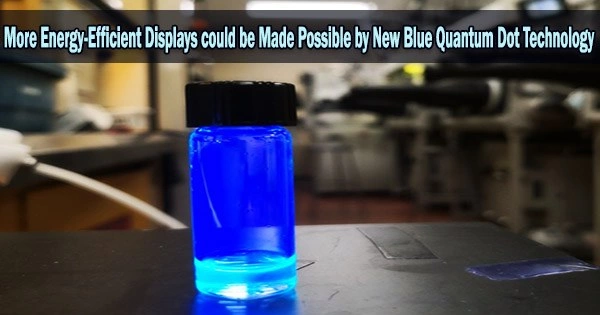Nanoscale crystals called quantum dots are able to emit a range of hues of light. Quantum dot-based displays offer improved power economy, brightness, and color purity over earlier display generations. Red, green, and blue are the three colors normally needed to display full-color images; blue has proven to be the most challenging to create.
A revolutionary approach based on self-organizing chemical structures provides a remedy, and the production and analysis of these innovative blue quantum dots required a state-of-the-art imaging methodology.
If you look closely at your device’s screen, you might be able to make out the individual pixels that make up the image. Although they can appear in nearly any color, subpixels, which are commonly red, green, and blue, make up pixels, making them the smallest element on your screen.
Since the intensity of these subpixels varies, each every pixel appears to be one color out of a vast array of colors. Subpixels’ underlying technology has advanced since the era of early color television, and there are now a variety of solutions available. But the next big leap is likely to be so-called quantum dot light emitting diodes, or QD-LEDs.
Although QD-LED displays are now available, the technology is still in its early stages, and the available models have several shortcomings, particularly with regard to their blue subpixels. The most significant blue subpixels are those of the three basic hues. Down-conversion is the process by which blue light is converted into green and red light.
Blue quantum dots hence need more precisely regulated physical characteristics. This frequently means that producing blue quantum dots is extremely difficult and expensive and that the quality of these dots is crucial to any display. But now, a team of researchers led by Professor Eiichi Nakamura from the University of Tokyo’s Department of Chemistry has a solution.
“Previous design strategies for blue quantum dots were very top down, taking relatively large chemical substances and putting them through a series of processes to refine them into something that worked,” said Nakamura.
“Our strategy is bottom up. We built on our team’s knowledge of self-organizing chemistry to precisely control molecules until they form the structures we want. Think of it like building a house from bricks rather than carving one from stone. It’s much easier to be precise, design the way you want, and is more efficient and cost-effective too.”
But the blue quantum dot created by Nakamura’s team is unusual not simply because of how it was created; when exposed to ultraviolet radiation, it emits almost flawless blue light, in accordance with the BT.2020 international standard for assessing color accuracy. This is because their dot has a special chemical composition that combines both organic and inorganic substances, such as lead perovskite, malic acid, and oleylamine.
Our strategy is bottom up. We built on our team’s knowledge of self-organizing chemistry to precisely control molecules until they form the structures we want. Think of it like building a house from bricks rather than carving one from stone. It’s much easier to be precise, design the way you want, and is more efficient and cost-effective too.
Professor Eiichi Nakamura
And only through self-organization can these be coaxed into the form required, which is a cube of 64 lead atoms, four to a side.
“Surprisingly, one of our biggest challenges was in finding that malic acid was a key piece of our chemical puzzle. It took over a year methodically trying different things to find it,” said Nakamura.
“Perhaps less surprising is that our other main challenge was to determine the structure of our blue quantum dot. At 2.4 nanometers, 190 times smaller than the wavelength of the blue light we sought to create with it, the structure of a quantum dot cannot be imaged by conventional means. So, we turned to an imaging tool pioneered by some of our team known as SMART-EM, or ‘cinematic chemistry’ as we like to call it.”
The advancement of electron microscope imaging known as “cinematic chemistry” is more analogous to filming a video than taking a still photo. This is crucial for capturing the structure of the blue quantum dot in its entirety because the nanocrystal is actually highly dynamic and just a portion of its tale can be conveyed by a single snapshot.
Unfortunately, the blue quantum dot also has a short lifespan, but this was to be expected. The team is now working with the industry to increase the stability of the blue quantum dot.





